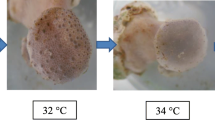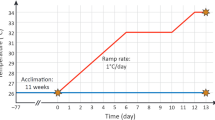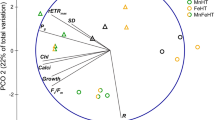Abstract
Coral reefs are one of the most biologically diverse and economically important ecosystems on earth. However, the destruction of coral reefs has been reported worldwide owing to rising seawater temperature associated with global warming. In this study, we investigated the potential of a redox nanoparticle (RNPO) to scavenge reactive oxygen species (ROS), which are overproduced under heat stress and play a crucial role in causing coral mortality. When reef-building coral (Acropora tenuis) larvae, without algal symbionts, were exposed to thermal stress at 33 °C, RNPO treatment significantly increased the survival rate. Proteome analysis of coral larvae was performed using nano-liquid chromatography-tandem mass spectrometry for the first time. The results revealed that several proteins related to ROS-induced oxidative stress were specifically identified in A. tenuis larvae without RNPO treatment, whereas these proteins were absent in RNPO-treated larvae, which suggested that RNPO effectively scavenged ROS from A. tenuis larvae. Results from this study indicate that RNPO treatment can reduce ROS in aposymbiotic coral larvae and would be a promising approach for protecting corals from thermal stress.






Similar content being viewed by others
References
Atad I, Zvuloni A, Loya Y, Rosenberg E (2012) Phage therapy of the white plague-like disease of Favia favus in the Red Sea. Coral Reefs 31:665–670
Baird AH, Bhagooli R, Ralph PJ, Takahashi S (2009a) Coral bleaching: the role of the host. Trends Ecol Evol 24:16–20
Baird AH, Guest JR, Willis BL (2009b) Systematic and biogeographical patterns in the reproductive biology of scleractinian corals. Annu Rev Ecol Evol Syst 40:551–571
Bassim K, Sammarco P (2003) Effects of temperature and ammonium on larval development and survivorship in a scleractinian coral (Diploria strigosa). Mar Biol 142:241–252
Berkelmans R, Van Oppen MJ (2006) The role of zooxanthellae in the thermal tolerance of corals: a ‘nugget of hope’ for coral reefs in an era of climate change. Proc R Soc B 273:2305–2312
Carpenter KE, Abrar M, Aeby G, Aronson RB, Banks S, Bruckner A, Chiriboga A, Cortes J, Delbeek JC, Devantier L, Edgar GJ, Edwards AJ, Fenner D, Guzman HM, Hoeksema BW, Hodgson G, Johan O, Licuanan WY, Livingstone SR, Lovell ER, Moore JA, Obura DO, Ochavillo D, Polidoro BA, Precht WF, Quibilan MC, Reboton C, Richards ZT, Rogers AD, Sanciangco J, Sheppard A, Sheppard C, Smith J, Stuart S, Turak E, Veron JE, Wallace C, Weil E, Wood E (2008) One-third of reef-building corals face elevated extinction risk from climate change and local impacts. Science 321:560–563
Chonpathompikunlert P, Fan C-H, Ozaki Y, Yoshitomi T, Yeh C-K, Nagasaki Y (2012) Redox nanoparticle treatment protects against neurological deficit in focused ultrasound-induced intracerebral hemorrhage. Nanomedicine 7:1029–1043
Epperly MW, Bahary N, Quader M, Dewald V, Greenberger JS (2012) The zebrafish—Danio rerio—is a useful model for measuring the effects of small-molecule mitigators of late effects of ionizing irradiation. In Vivo 26:889–897
Gleason DF, Edmunds PJ, Gates RD (2006) Ultraviolet radiation effects on the behavior and recruitment of larvae from the reef coral Porites astreoides. Mar Biol 148:503–512
Haider S, Pal R (2013) Integrated analysis of transcriptomic and proteomic data. Curr Genomics 14:91–110
Hayashibara T, Shimoike K, Kimura T, Hosaka S, Heyward A, Harrison P, Kudo K, Omori M (1993) Patterns of coral spawning at Akajima Island, Okinawa, Japan. Mar Ecol Prog Ser 101:253–262
Howells E, Beltran V, Larsen N, Bay L, Willis B, Van Oppen M (2012) Coral thermal tolerance shaped by local adaptation of photosymbionts. Nat Clim Chang 2:116–120
Hughes TP, Kerry JT, Álvarez-Noriega M, Álvarez-Romero JG, Anderson KD, Baird AH, Babcock RC, Beger M, Bellwood DR, Berkelmans R (2017) Global warming and recurrent mass bleaching of corals. Nature 543:373–377
Masuda T, Tomita M, Ishihama Y (2008) Phase transfer surfactant-aided trypsin digestion for membrane proteome analysis. J Proteome Res 7:731–740
Moberg F, Folke C (1999) Ecological goods and services of coral reef ecosystems. Ecol Econ 29:215–233
Morgan MJ, Liu Z (2011) Crosstalk of reactive oxygen species and NF-κB signaling. Cell Res 21:103–115
Morisaka H, Matsui K, Tatsukami Y, Kuroda K, Miyake H, Tamaru Y, Ueda M (2012) Profile of native cellulosomal proteins of Clostridium cellulovorans adapted to various carbon sources. AMB Express 2:37
Peixoto RS, Rosado PM, de Assis Leite DC, Rosado AS, Bourne DG (2017) Beneficial microorganisms for corals (BMC): proposed mechanisms for coral health and resilience. Front Microbiol 8:341
Singh RP, Ramarao P (2013) Accumulated polymer degradation products as effector molecules in cytotoxicity of polymeric nanoparticles. Toxicol Sci 136:131–143
Takahashi S, Nakamura T, Sakamizu M, van Woesik R, Yamasaki H (2004) Repair machinery of symbiotic photosynthesis as the primary target of heat stress for reef-building corals. Plant Cell Physiol 45:251–255
Vong LB, Kobayashi M, Nagasaki Y (2016) Evaluation of the toxicity and antioxidant activity of redox nanoparticles in zebrafish (Danio rerio) embryos. Mol Pharm 13:3091–3097
Vong LB, Mo J, Abrahamsson B, Nagasaki Y (2015a) Specific accumulation of orally administered redox nanotherapeutics in the inflamed colon reducing inflammation with dose-response efficacy. J Control Release 210:19–25
Vong LB, Yoshitomi T, Matsui H, Nagasaki Y (2015b) Development of an oral nanotherapeutics using redox nanoparticles for treatment of colitis-associated colon cancer. Biomaterials 55:54–63
Voolstra CR, Schnetzer J, Peshkin L, Randall CJ, Szmant AM, Medina M (2009) Effects of temperature on gene expression in embryos of the coral Montastraea faveolata. BMC Genomics 10:627
Water JA, Ainsworth TD, Leggat W, Bourne DG, Willis BL, Oppen MJ (2015) The coral immune response facilitates protection against microbes during tissue regeneration. Mol Ecol 24:3390–3404
Weis VM (2008) Cellular mechanisms of cnidarian bleaching: stress causes the collapse of symbiosis. J Exp Biol 211:3059–3066
Wilkinson C (ed) (2004) Status of coral reefs of the world: 2004. Global Coral Reef Monitoring Network and Australian Institute of Marine Science
Yakovleva IM, Baird AH, Yamamoto HH, Bhagooli R, Nonaka M, Hidaka M (2009) Algal symbionts increase oxidative damage and death in coral larvae at high temperatures. Mar Ecol Prog Ser 378:105–112
Yellowlees D, Rees TAV, Leggat W (2008) Metabolic interactions between algal symbionts and invertebrate hosts. Plant Cell Environ 31:679–694
Yorifuji M, Harii S, Nakamura R, Fudo M (2017) Shift of symbiont communities in Acropora tenuis juveniles under heat stress. Peer J 5:e4055
Yoshitomi T, Hirayama A, Nagasaki Y (2011) The ROS scavenging and renal protective effects of pH-responsive nitroxide radical-containing nanoparticles. Biomaterials 32:8021–8028
Young CC, Rekha PD, Lai WA, Arun AB (2006) Encapsulation of plant growth-promoting bacteria in alginate beads enriched with humic acid. Biotechnol Bioeng 95:76–83
Zhang Y, Martin SG (2014) Redox proteins and radiotherapy. Clin Oncol 26:289–300
Author information
Authors and Affiliations
Corresponding author
Ethics declarations
Competing Interests
The authors declare that they have no competing interests.
Electronic Supplementary Material
ESM 1
(XLSX 35 kb)
Rights and permissions
About this article
Cite this article
Motone, K., Takagi, T., Aburaya, S. et al. Protection of Coral Larvae from Thermally Induced Oxidative Stress by Redox Nanoparticles. Mar Biotechnol 20, 542–548 (2018). https://doi.org/10.1007/s10126-018-9825-5
Received:
Accepted:
Published:
Issue Date:
DOI: https://doi.org/10.1007/s10126-018-9825-5




